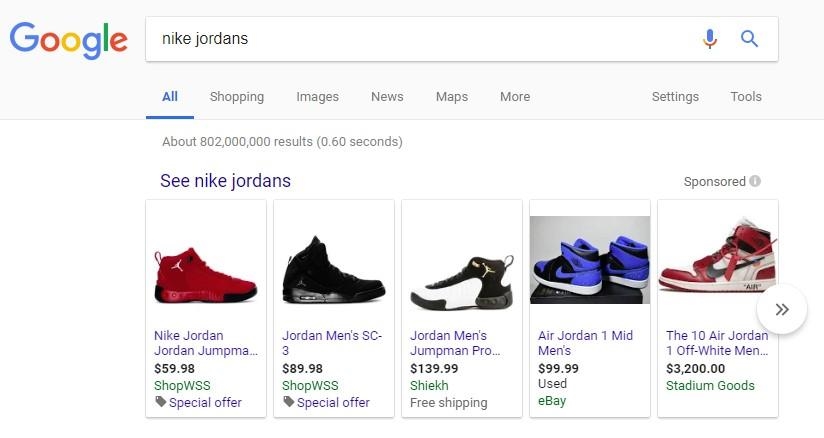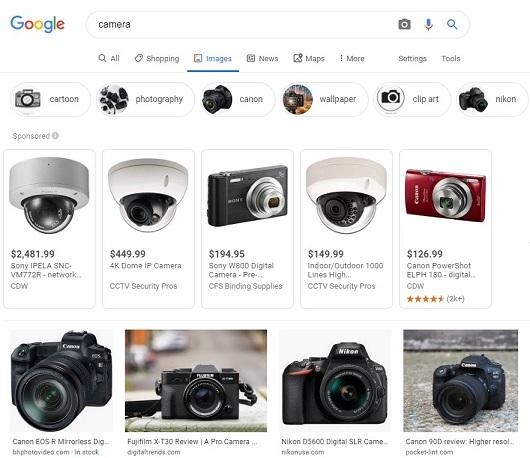As 2020 approaches, the stakes have never been higher for online retailers trying to compete with sellers flooding marketplaces from retailers like Amazon and Walmart—and, in some cases, the direct-to-consumer retailers themselves.

But, thankfully, it is not a hopeless task: We compiled 12 of the best expert-approved ecommerce marketing strategies that you need to try in 2020. By implementing these strategies, ecommerce brands can find the holy grail, which remains the right consumer on the right device at the right moment.
Let’s get started.
1. Implement Google Shopping ads
One popular strategy is using the ad platform Google Shopping, which shows users products related to their Google searches—and when that user clicks on an item, they are ushered directly to the seller’s site.node:field_content]

Per Gil Gildner, co-founder of search marketing company Discosloth, narrowly targeted Shopping ads in particular are “one of the easiest and most cost-effective [ways] of getting more product sales for an ecommerce company.”
That’s because they effectively pre-vet potential customers by showing the product image and the price, so advertisers only get highly targeted clicks.
“This is extremely easy to implement on platforms like Shopify or WooCommerce,” he added.
And they work. Nikki Bisel, founder of digital marketing consultancy and agency Seafoam Media, said Google Shopping campaigns have resulted in as much as a 200% increase in conversion rate and click-through rate (CTR) by targeting consumers who have already interacted with a given brand by putting products in their carts or browsing product categories.
“In narrowing our audience, we see a drop in overall clicks, but a huge uptick in CTR and conversions—a win-win-win situation in terms of budget and ROI,” she said.
Specifically, try out Google showcase shopping ads
Ruba Aramouny, owner and strategic director of Solid Marketing, suggested using Google’s showcase shopping ads to help attract top-of-funnel traffic at a lower cost. This feature allows advertisers to group related products together to help introduce a brand to users searching with more generic product terms.

“What makes Showcase ads so interesting is that you can bid lower than you typically would on a traditional Shopping ad, while showing prospects a wide variety of products and images,” she said. “Even if a prospect doesn’t immediately make a purchase on your store, you’ve familiarized them with your brand and can build a warm audience to remarket to at a lower cost.”
2. Add structured markup language
For his part, Kent Lewis, president and founder of digital marketing agency Anvil Media, said brands should add structured markup language, which is also known as schema, to the backend of their product pages to help search engines index them properly. And, because this makes it easier for the search engine to know the information on a given page, there’s potential for a rankings boost, too.
“By adding rich snippets, you help Google put your products in front of the right people for the right search terms,” said Beth Kearsley operations assistant at search marketing agency Tao Digital.
3. Optimize for voice search
Olga Mykhoparkina, CMO of team chat platform Chanty, predicts voice search will be the biggest trend for ecommerce marketing strategies in 2020.
“As more buyers are using voice to search for products, brands that optimize their content for these search terms will have the upper hand in grabbing organic traffic from search engines,” she said.
The biggest challenge is there still aren’t many tools to analyze popular voice search terms, but she nevertheless believes 2020 will be the year content and SEO begin to accommodate voice.
“For ecommerce and local-based companies, this will be the ideal opportunity to capitalize on long-tail keywords without unnaturally stuffing them into their content,” she added.
For brands that are more cautious about voice technology, John Frigo, digital marketing lead at MySupplementStore.com, said another communication option shoppers actually use is SMS and push notifications, which have huge open rates. And because not a lot of marketers are using it yet, brands can stand out.

“Whereas everyone is coming at people in email, Google search and social, people aren’t being inundated with marketing messages via text or push,” he said. “SMS is great in that you get right in front of someone and also most people don’t know how to turn it off.”
4. Focus on site speed
Ecommerce brands will also want to make sure their websites are “bang on,” Kearsley said—including site speed, header tags, and interactive media.
“Getting these right will greatly increase your site’s visibility and click-through rates,” she said.
Clark Covington, marketing manager at Jelly Bean Rubber Mulch, agreed good things happen when website load speed increases, including improvement in the performance of the brand’s online ecommerce page.
“Specifically, we found that when website load speed increases Google will rank pages higher in search results for relative keywords by increasing our page speed score in our paid Google Ads account,” he said. “Most striking of all, we found a Google study showing a 90% increase in bounce rate when load speed goes from 1 to 5 seconds.”
In addition, Lewis recommends optimizing images specifically for commerce, as Google Images is the second-largest search engine by volume.
“Optimizing your product images with alt text is essential to ensuring they rank in product-related images searches,” he said. “The images link to the product pages where interested parties can purchase [them] easily.”

5. Make lots of (relevant) videos
According to Jeff Neal who works with the online marketplace The Critter Depot, the ecommerce brands that will win in 2020 will create YouTube channels with videos that answer relevant questions to a given customer base.
“We sell live feeder insects to reptile owners through the mail,” he said. “So we created a handful of videos that we posted on our product pages that discuss how to breed crickets, how to store your crickets and superworms and what it’s like to unbox them.”
The result?
“These videos have done a nice job increasing our on-page time by over a minute per page,” he said. “So we’re pushing forward and creating more videos for our top-converting pages.”
Matthew Ross, COO of mattress review website The Slumber Yard, agreed YouTube can help drive traffic and revenue because in part Google tends to organically rank relevant videos higher on the first results page, making this a more cost-efficient strategy than PPC—to the tune of 2 million views for The Slumber Yard last year.
“All in all, this strategy has easily saved us hundreds of thousands of dollars that we otherwise would have spent on digital ads,” he added.
6. Tap into UGC and influencer marketing
Like email signups, Prafull Sharma, CEO of content marketing agency LeadsPanda, recommends brands encourage their fans to produce their own content in exchange for an incentive. This will increase engagement and conversions, as well as build trust within the brand’s digital community. Camera brand GoPro is a good example. Its YouTube channel has nearly 8 million subscribers and a library of high-quality videos from customers.
“Customers are featured on their channel and GoPro gains content—an exchange that builds a relationship between the audience and the brand,” he added.
That’s because user-generated content evokes more trust than content from brands.
“[User-generated] content, like reviews and testimonials in the form of photos or videos and published both on the brand’s social media platforms and ecommerce site, seems more believable for customers, knowing that the brand is not only selling with their own produced content,” Sharma said.
UGC from micro-influencers can also help maintain the authenticity and authority some big-time influencers have lost.
Indeed, citing figures from the Digital Marketing Institute, Sarah Donawerth, content manager at influencer marketing platform Carro, said 49% of consumers rely on influencer recommendations when making a purchase decision, so influencer marketing is an easy way to make trustworthy content potential customers will enjoy.
“Normally when we think of influencers, we think of a Kardashian-level celebrity with millions of followers,” said Meaghan Brophy, senior retail analyst at small business resource Fit Small Business. “However, accounts with smaller, yet more engaged, followers provide businesses with higher conversions for a smaller price.”

Brands looking for micro-influencers can search hashtags and interests related to their products and then monitoring the type of content posted and the engagement it receives.
“The challenge for ecommerce businesses in terms of integrating UGC into their marketing strategy is how to achieve this organically without crossing the line into sponsorship and identifying and incentivizing sufficient users to make a worthwhile effort,” said Polly Kay, senior marketing manager at window treatment company English Blinds.
After inviting potential partners to collaborate, Donawerth said brands should ship their products so content creators can try them out and then honestly recommend the right ones to their respective audiences.
7. Try filters and QR codes
Sneh Ratna Choudhary, content marketer at proximity marketing company Beaconstac, said filters on social platforms like Snapchat and Instagram can yield unique shopping experiences for ecommerce brands. That includes denim brand Levi’s, which allowed Snapchat users to scan QR codes in-store to virtually try on a jacket they could then by online, and Kylie Jenner’s makeup brand Kylie Cosmetics, which used Instagram filters to let users see what her new lipsticks looked like.
On a related note, QR codes in print ads allow consumers to easily visit advertisers’ websites.
“These QR Codes are usually dynamic which allows users to unlock new offers at different times of the day,” Choudhary said. “Amazon sent a toy catalog to millions of its customers last November that contained QR codes that allowed parents to shop for toys for their kids seamlessly. This served them well given the vacuum that was created once Toys R Us was shut down.”
8. Make shopping social
Aalap Shah, founder of Amazon/ecommerce-focused agency 1o8, said to consider social commerce platform CommentSold.
“I’m finding for my apparel and beauty clients in particular that this tool creates an effective new sales channel to drive directly into Shopify or owned e-comm sites and stores,” he said. “Social selling in itself is not new, but the tools to create momentum and ease [through automated invoicing, sales analytics, customer data and inventory and order management] are getting better and better.”

9. Send personalized emails
It’s an oldie, but a goodie: Email marketing. Especially personalized ones.
Brands that are looking to incentivize signups should consider lures like coupons and free trials.
Bernard Wong, digital marketer for ecommerce site Vape Club, said this strategy has helped the online e-liquid store amass a list of over 45,000 emails so far in the U.K. In addition, he said customers of ecommerce platform Shopify can easily implement the tactic by installing apps from the Shopify App Store like Woohoo.
For his part, Tom Buchok, founder of email monitoring firm Mailcharts, cautioned brands to pay attention to tone, subject line and clickbait-y words that might trigger spam filters in the emails they send customers and leads.
And, according to Tanya Yablonskaya, an ecommerce industry analyst at software development firm ScienceSoft, personalization, or researching a customer’s purchasing habits and then customizing their interaction as a result, is another important email tactic for ecommerce brands.
There are two ways to do this: with recommended products and targeted promotions during a customer’s digital journey; and with personalized follow-up emails.
“Of course, excellence in the art of personalization comes with practice: the more you experiment and track the success of your tries, the more understanding of your customers you gain and can talk to them more effectively thereafter,” she said.
Brophy suggested using personalization in emails to retarget customers with abandoned carts.

“[These] emails alone … remind shoppers of left-behind items can have a big impact on sales,” she said. “However, the most effective emails are personalized to include the shopper’s name and a special offer or call-out to a previous purchase or browsing history.”
10. Write newsletters and blog posts
And, of course, you’ll want content. Lots of content.
Calloway Cook, president of dietary supplement company Illuminate Labs, suggests guest blogging as an effective—and cost-effective—strategy for 2020.
He recommends using a tool like the browser extension MozBar to find the domain authority of sites and to only reach out to those with a domain authority greater than 40.
“It’s a proven way to get high-quality backlinks pointed to your homepage and increase your site’s domain authority [and thereby increase your site’s organic rankings],” Cook said.
Gildner agreed long-form blog posts with informational guides can boost organic SEO by as much as 2 to 3x over the course of a year.
For her part, Andrea Loubier, CEO of desktop email client Mailbird, said well-written content gives potential and existing customers alike a reason to visit your ecommerce site. This provides useful information, such as positioning the brand as an expert on a given subject, which, in turn, gives potential customers more of a reason to shop with said brand.
“All content marketing strategies are different, especially dependent on the niche,” Loubier said. “But all of the best are comprised of several different methods, incorporating newsletters, emails, social media, and link building. Consider your content as a free offer to potential or existing clients, which can be used as a tool to create new purchases and other additional sources of revenue.”
11. Issue coupons
Not surprisingly, Sara McQueen, digital PR executive at content marketing agency Fractl, said client Shopper.com, which applies discount codes for users when they check out, found coupons are the way to go. That’s in part because nearly one in three shoppers actively look for discount codes nearly every time they make a purchase online—and that’s expected to go up in the coming year.

But, McQueen said, in interviews with 1000 customers in the U.S. and U.K., Shopper.com learned consumers feel 3x savvier when they find coupons in online searches than if they are simply handed to them. In addition, McQueen said one in three consumers said they would feel annoyed if a retailer did not make them aware of potential savings and three in five would ask for a refund if they found they missed out on a discount after purchase.
12. Use data and automation to make connections
Naturally, you’ll want to use all the customer data at your disposal, but George Afouxenidis, digital marketing content writer at bulk SMS service Routee, said brands should also connect touchpoints to make their customer journey seamless.
“Following the behavioral patterns of your website visitors can help you build progressive profiles that enable personalized communications and lead to higher conversion rates,” he said. “Through a capable marketing automation platform such valuable generated data as the touchpoints of customers on ecommerce sites and brick-and-mortar stores allow for deeper segmentation of your individual visitors.”
Using segmented data, brand can send highly personalized messages with greater power to convert, which is precisely what a clothing retailer in Greece has done—and it increased online sales and foot traffic to its flagship store by more than 35% in a month.
“Sending appropriately timed campaigns during the summer holiday season, customers were alerted just before their weekend escapades of offers on swimsuits, suntan lotions and beach accessories,” he said.

Seasonal email example from Bloomsbury Academic.
The same campaign was launched on the ecommerce site and followed customers on their journey.
“Through an automated segmentation process, audiences who expressed interest on beachwear and other holiday accessories were also targeted for offers that matched their preferences, geographic location and demographic characteristics,” Afouxenidis said. “The results were nothing short of spectacular. These carefully targeted campaigns managed to stir the interest of casual shoppers and returning customers, who then proceeded to buy season-appropriate goods when least expected, during their weekday breaks from work.”
Test out these ecommerce marketing strategies
Remember, the best way to figure out what works for your audience is to test. So try out these expert-approved ecommerce marketing strategies to boost sales and revenue in 2020!
Digital & Social Articles on Business 2 Community
(71)





